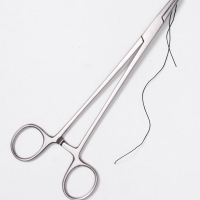
In this blog for surgeons and anyone about to undergo surgery, Christina Uwins, Senior Research Fellow in Robotic Gynaecological Oncology, looks at the latest Cochrane evidence on stitches that go under the skin (subcuticular) for skin closure and asks what is the best way to close your skin?
Skin closure can be performed in many ways and often comes down to a surgeon’s preference. Strong beliefs are held by surgeons all over the world about the best way to close the skin. Many strongly support the use of staples or interrupted removable sutures due to their speed, ease of use and ability to allow wounds to drain, believing this reduces the risk of infection or wound complications. Others prefer the use of absorbable stitches under the skin, believing this gives a superior cosmetic appearance and avoids the need for potentially uncomfortable suture removal. With stitches that go under the skin, as no foreign material goes through the skin (except possibly the suture ends), there are no or reduced mark points it is possible that this may lead to less wound infections. However, whether stiches that go under the skin increase or decrease the incidence of wound complications remains a point of controversy.
In recent weeks, during the COVID-19 pandemic, many hospitals and GP practices have reduced face-to-face patient contact, reducing clinic visits and the need to attend for treatment. In order to avoid patients returning to the hospital to have sutures removed, some surgeons have moved to using subcuticular absorbable sutures.
What we already know
Surgical wounds can be closed in a variety of ways using a variety of devices including sutures placed under the skin (subcuticular) or through the skin (transdermal), staples and tissue adhesives. Fancy devices such as medical tapes and zippers can also be used. Sutures can be absorbable (dissolve in the body as part of the healing process) so they do not need removing, or non-absorbable, requiring removal once the wound has healed.
Wound complications are among the most common complication following surgery, affecting the cosmetic appearance of wounds, prolonging hospital stay and reducing quality of life, while time and care is taken for them to heal.
What factors may increase the risk of surgical wound infection? [1]
- obesity
- smoking
- diabetes
- old age
- malnutrition
- immunosuppressive treatment including chemotherapy and steroids
- prolonged hospital stay
- prolonged surgery
- vascular disease
New Cochrane evidence on sutures placed under the skin
So what form of skin closure is the best and safest? A recent Cochrane Review by Goto et al [2], published this year, called “Subcuticular sutures for skin closure in non-obstetric surgery” investigated this. Goto et al reviewed the evidence regarding the effectiveness and acceptability of sutures that go under the skin for surgery not related to childbirth.
Goto et al looked at all the best available evidence up March 2019. They identified a total of 64 studies with 7487 participants. Most of these studies compared stitches that go under the skin (subcuticular) with stitches that go through the skin (transdermal), skin staples or tissue glue. The main outcome of interest was whether wounds became infected.
What were the key findings?
Patients were probably more statisfied with stitches that went under the skin compared to those that go over the skin (moderate-certainty evidence). Tissue adhesives, however, may improve patient satisfaction in comparison to stitches that go under the skin (low-certainty evidence).
The strongest evidence is for the comparison between stitches that go under the skin and staples. Stitches under the skin were found to be more satisfactory to patients (high-certainty evidence), probably had fewer wound complications (moderate-certainty evidence) and probably on average decrease hypertrophic scars (thickened scars) in comparison to stapels (moderate-certainty evidence). Staples may be quicker to apply compared to stitches under the skin (low certainty evidence). There was probably little or no difference between the two methods for the number of wound infections (moderate-certainty evidence). Indeed, there may be little or no difference in the number of wound infections for any of the skin closure methods investigated (stitches that go over the skin, staples, glue, tapes and zippers).
There was little or no difference found between the different closure methods when it came to looking at pain or length of hospital stay. However, only few studies reported on these outcomes, so uncertainty remains. Effects on quality of life were not reported in the studies. The evidence for surgical tapes and zippers is of very low-certainty. More research is required on these.
Conclusion
There appears to be little or no difference in the number of wound infections following surgery between the closure methods investigated. Stitches that go under the skin or tissue glue appear to be associated with higher patient satisfaction. Stitches under the skin probably had fewer wound complications (moderate-certainty evidence) and probably on average decrease hypertrophic scars (thickened scars) in comparison to stapels (moderate-certainty evidence) but may take longer to apply.
References
- NICE. Surgical site infection Clinical Guideline. https://www.nice.org.uk/guidance/ng125/evidence/october-2008-full-guideline-pdf-6727105694. Published 2008. Updated October 2008. Accessed 10/05/2020, 2020.
- Goto S, Sakamoto T, Ganeko R, Hida K, Furukawa TA, Sakai Y. Subcuticular sutures for skin closure in non‐obstetric surgery. Cochrane Database of Systematic Reviews 2020, Issue 4. Art. No.: CD012124. DOI: 10.1002/14651858.CD012124.pub2. https://www.cochranelibrary.com/cdsr/doi/10.1002/14651858.CD012124.pub2/full

Christina Uwins
Christina is a Senior Clinical Research Fellow in Robotic Gynaecological Oncology currently working towards an MD. She has a 1st Class Honours in BSc Medical Sciences and two distinctions in her clinical years whilst at the University of Aberdeen medical school. She was awarded The Royal Society of Tropical Medicine and Hygiene National Undergraduate Project Prize in 2004 and Dr CC Smith Elective Prize (Endowed by Glaxo-Smith Kline) 2005 for her research.
During her postgraduate training Christina has gone on to gain her MRCS and MRCOG. Christina's research interest is in Robotic Surgery, specifically how it can be used to help women with Ovarian Cancer. She is currently working towards an MD with the University of Surrey at Royal Surrey County Hospital which is the UK’s first epicentre for training in robotic surgery, a recognised centre for minimal access surgical training and research in enhanced recovery. It also has by far the greatest experience in the UK in the use of robotics in gynaecological oncology, having performed over 1000 gynae-oncology robotic operations.
Christina is the principal author on the Cochrane intervention Review Minimally invasive surgery (robotic or laparoscopic) versus laparotomy for advanced ovarian cancer, and is greatly enjoying learning new skills supported by the Cochrane editorial team. Following her MD, Christina plans to undertake Gynaecological Oncology subspeciality training with a view to becoming a Consultant in Gynaecological Oncology.
Christina was a member of the 2018/2019 Cochrane UK and Ireland Trainees Advisory Group.
Posted: May 2020.
